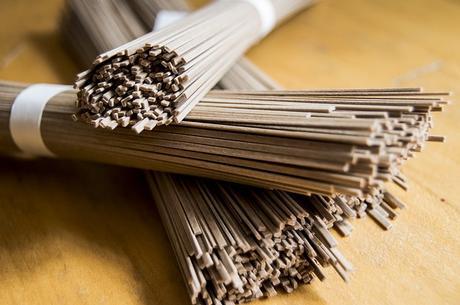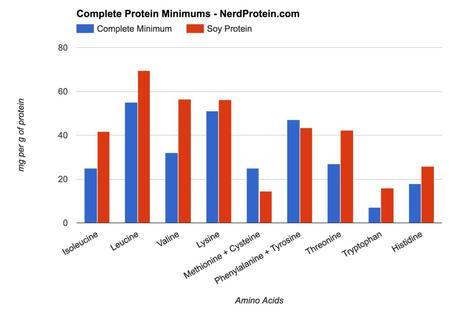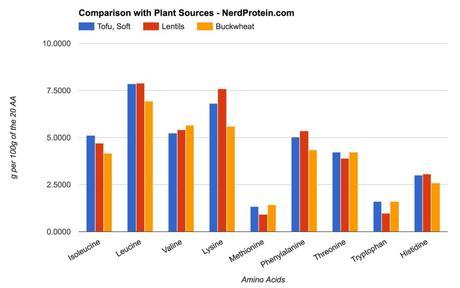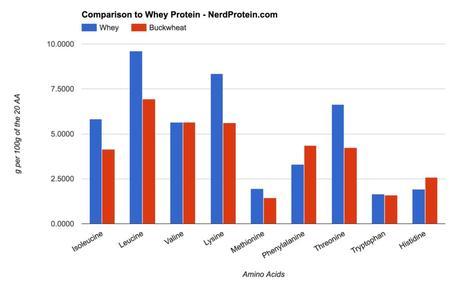Buckwheat isn’t a grain and has nothing to do with wheat. It’s actually more like a nut than anything but the nuts look grain-like. It’s useful if you’re trying to avoid grains for a particular reason.
The seeds can be consumed as is after boiled or soaked in water. Also, buckwheat noodles can be purchased and used as you would any noodle, just adapt your recipes for flavor and texture difference.

Is Buckwheat Protein Complete?
Buckwheat protein isn’t complete so be careful if you’re eating minimal amounts of protein. The amino acids that don’t quite meet the minimum are methionine+cysteine and phenylalanine+Tyrosine. Otherwise, the branch chain amino acids (BCAAs) are all passing.

Buckwheat Protein Density
As usual we look at the amount of protein relative to calories. However, we express it as the number of calories of the food you have to eat to get one gram of protein.
As you can see below, buckwheat isn’t a very good source of protein. If you had a protein target of 100g you would already be at 2,589 Calories if you could only use buckwheat (don’t actually do this… it’s just useful to see how expensive a food happens to be.) Still, buckwheat does better than quinoa.
Source Density (Calories per g of protein)
Pure Protein 4.00
Pacific Cod 4.54
Egg Whites 4.77
Turkey Breast 4.88
Alaskan Halibut 5.11
Chicken Breast 5.32
Whey 4.40
Tofu, Soft 8.51
Lentils 12.86
Black Beans 14.90
Pinto Beans 15.87
Buckwheat 25.89
Quinoa 27.27
Brown Rice 48.28
Other Nutrients and Minerals in Buckwheat
Buckwheat is an outstanding source of minerals, as you can see in the table below. Beyond the minerals, we also see that buckwheat is a good source of B vitamins like other small seeds and grains. As usual the values below are for 100g of buckwheat. Shift the decimal place twice to get the per gram values.
%DV
Manganese 65%
Magnesium 58%
Copper 55%
Phosphorus 35%
Vitamin B3/Niacin 35%
Vitamin B2/Riboflavin 25%
Zinc 16%
Potassium 13%
Iron 12%
Selenium 12%
Vitamin B5/Pantothenic Acid 12%
Comparison with Lentils and Soy
For many of us, the first thing we tend to look at is leucine because of it’s importance in muscle. Here we see that the leucine content isn’t as robust as soy bean curd or lentils. Methionine is low but isn’t terrible. The same can be said of phenylalanine.

Comparison with Whey
Whey is well know for being a great source of leucine and is so familiar with those in the fitness community that it makes a great reference. Here we can see just how far off leucine is from one of the top sources. For methionine as well we can see the difference. Interestingly, we can see that the phenylalanine content of buckwheat is actually much higher than that of whey.

Conclusion
I first learned of buckwheat from a survival channel called Survival Russia, a link to the video is below.
Overall, if you need a food that is high in calories but still comes with some protein then look no further. Buckwheat fits the bill perfectly. Survival situations, in particular, have this kind of need. The high calories also offset some of the demand for protein (Remember as the number of calories in goes down the demand for protein goes up.)
Remember that buckwheat noodles exist and are popular in Japan. A noodle form opens the door for a variety of recipes.
Leave a comment in below. I don’t know of any recipes for buckwheat, mainly because I haven’t located a source near me yet, but feel free to leave them in the comments as well.
